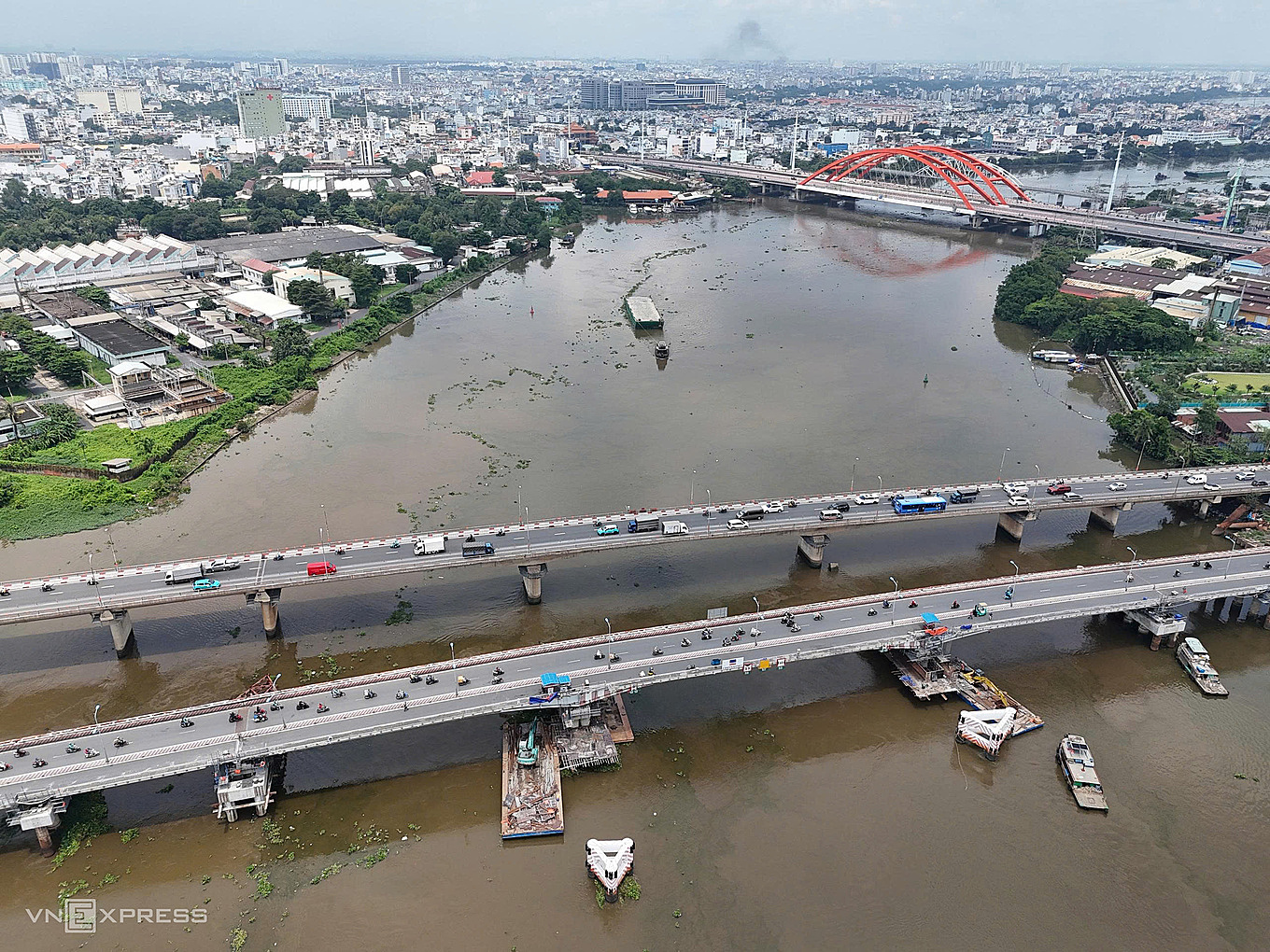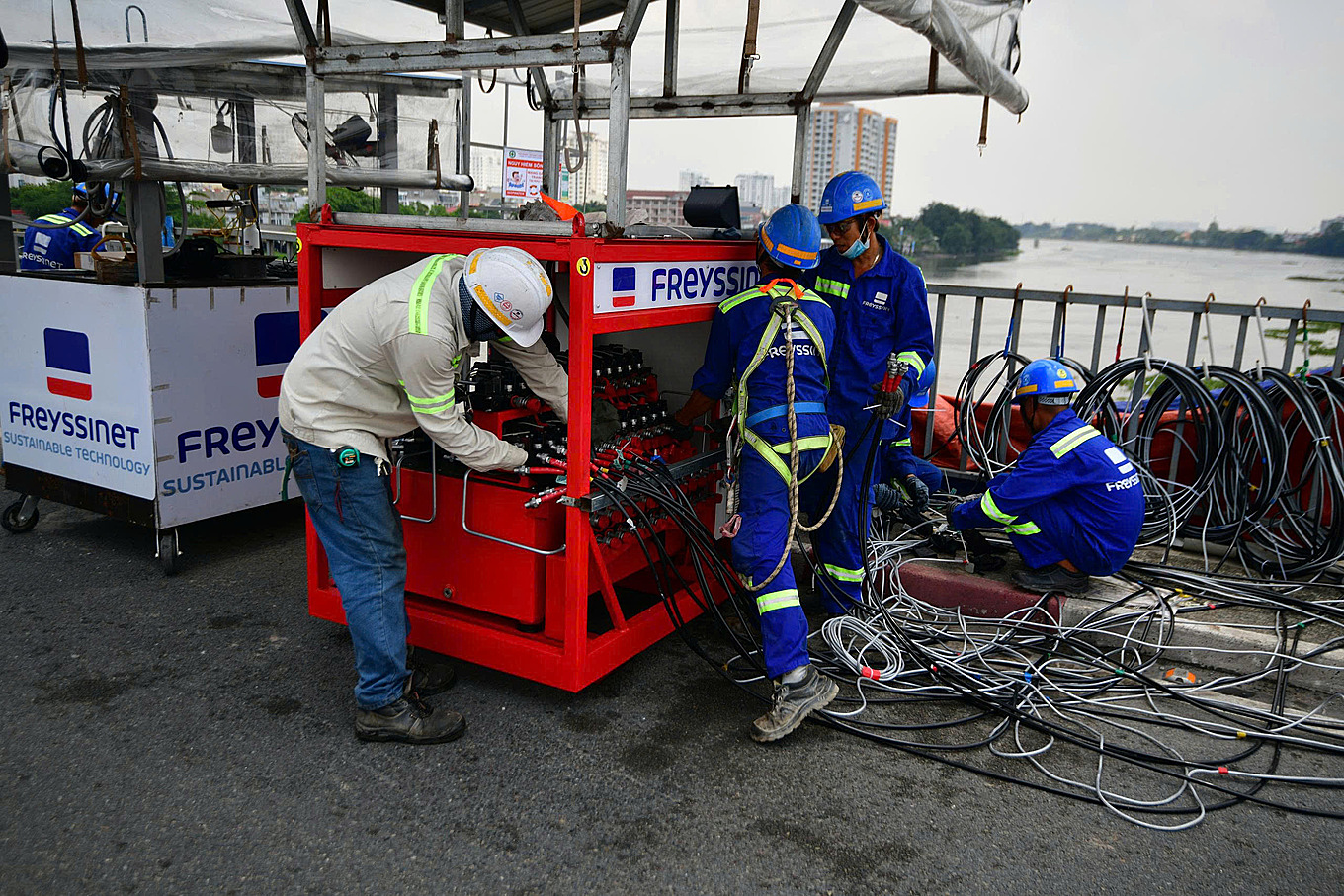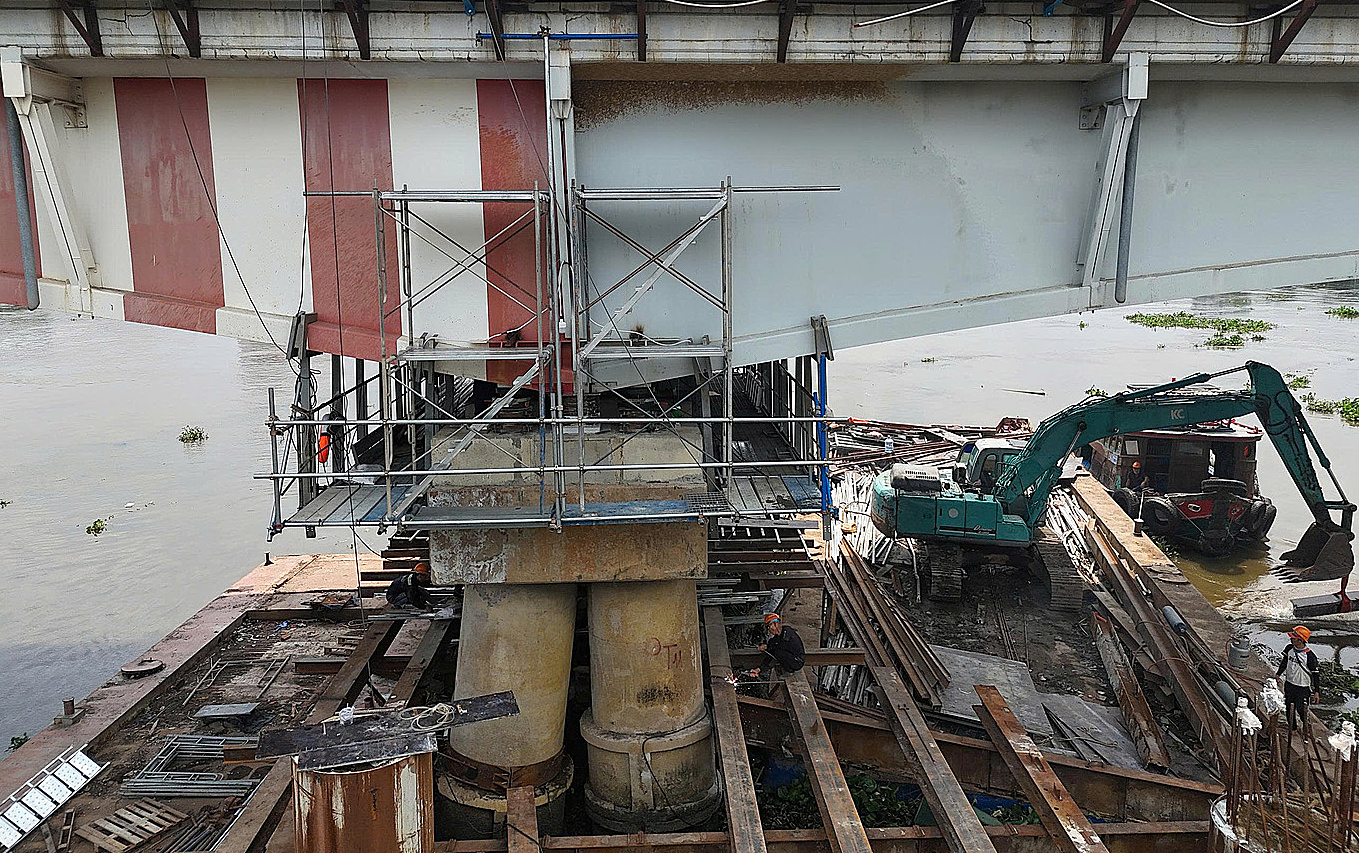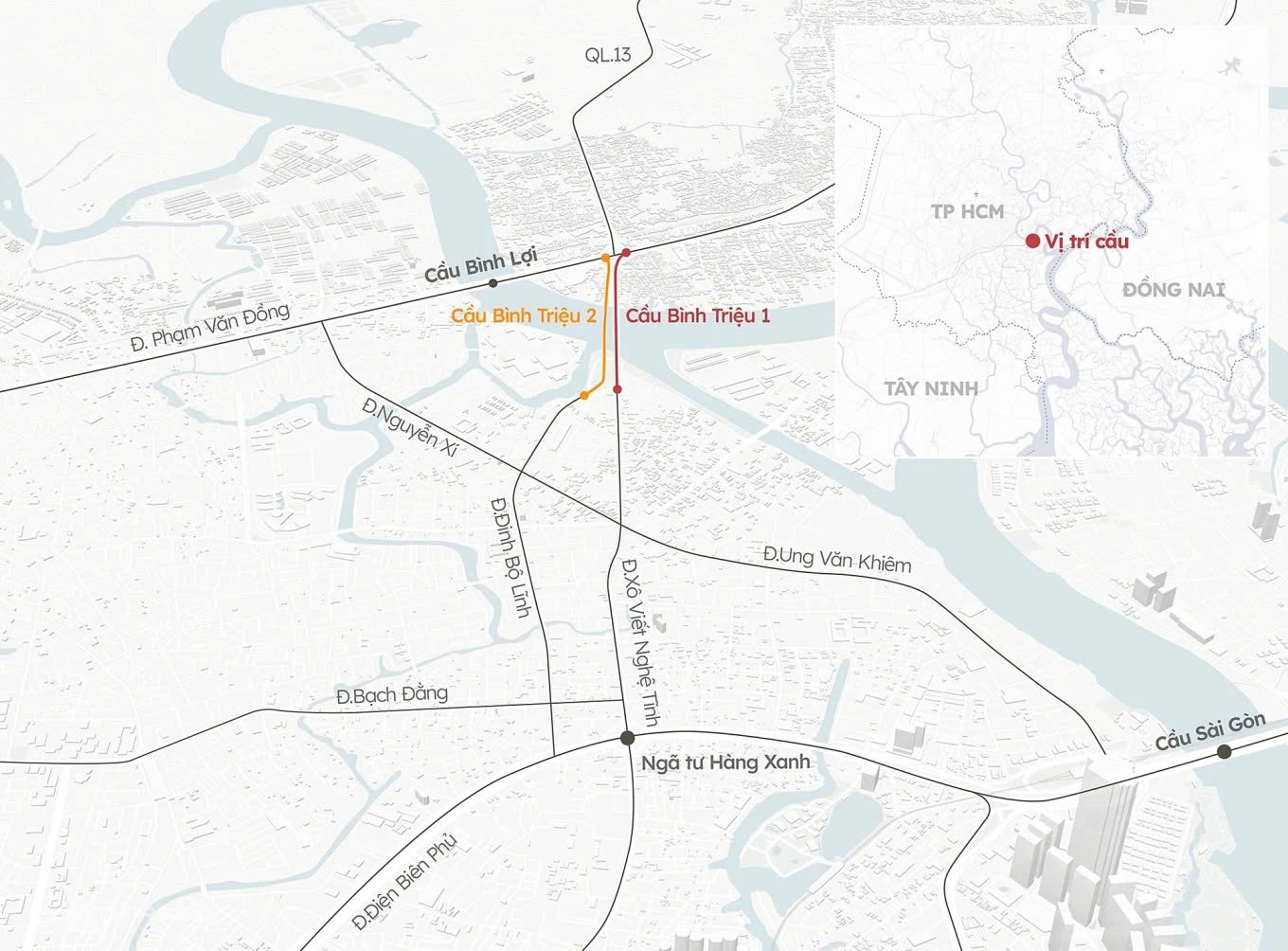Built before 1975, the Binh Trieu 1 Bridge spanning the Saigon River is a crucial link to the eastern part of the city. In 2010, the bridge was repaired and widened to accommodate three lanes of traffic. Along with the parallel Binh Trieu 2 Bridge, this structure forms a vital transportation artery connecting Binh Duong Province and Thu Duc City via National Highway 13 to downtown Ho Chi Minh City and the former Mien Dong Bus Station.
 |
Binh Trieu 1 Bridge (foreground) undergoing clearance elevation in 9/2025. The red section is Binh Loi Bridge on Pham Van Dong Street. Photo: Giang Anh |
Binh Trieu 1 Bridge (foreground) undergoing clearance elevation in 9/2025. The red section is Binh Loi Bridge on Pham Van Dong Street. Photo: Giang Anh
After years of operation, Binh Trieu 1 Bridge revealed a shortcoming: its navigational clearance (the height from the highest water level to the bottom of the bridge) was only 5.5 m—significantly lower than the required 7-9.5 m for the area. This limitation hindered water traffic and failed to meet the growing demand for larger vessels accessing the port.
After careful consideration, the city chose to raise the bridge using a hydraulic jacking system to ensure the project's safety and structural integrity. With a total investment of 133 billion VND, this solution is estimated to save trillions of VND compared to building a new, similar structure.
The bridge renovation began in late 2024. The most critical and complex phase, raising the entire 11,000-ton structure, took place from late August to November of this year. This was considered the most challenging part of the upgrade. During construction, motorcycles were still allowed to cross the bridge to alleviate traffic congestion on the adjacent bridge.
 |
Equipment mobilized to the construction site in 9/2025. Photo: Giang Anh |
Equipment mobilized to the construction site in 9/2025. Photo: Giang Anh
Nguyen Viet Quang, Head of Infrastructure Management Division No. 2 (Road Infrastructure Management Center - Ho Chi Minh City Department of Construction), said the biggest challenge was uniformly raising the massive structure while maintaining stability. This new technology was led by domestic engineers.
The project utilized 106 hydraulic jacks placed under the bridge spans, including 76 jacks with a capacity of 400 tons and 30 jacks with a capacity of 500 tons. All were connected to sensors and controlled via a central computer, with a margin of error controlled within 1 mm. The bridge was raised an average of 4-8 cm per day, with continuous vibration monitoring.
The bridge comprises 16 concrete spans and three main steel spans. During the 2010 renovation, the contractor Freyssinet connected these into four continuous spans, each 140 m long. Therefore, the lifting process was carried out sequentially from span 1 to 4, and then repeated, ensuring synchronization.
According to the investor, this method is similar to the "genie lift" house raising technique but far more complex due to the substantial load and stringent technical requirements. Since 26/8, cars have been prohibited from crossing the bridge, with only motorcycles allowed, further complicating traffic management and construction during simultaneous operation.
"Out of the three months, the jacking took about one month. The remaining two months focused on reinforcement, installation, and load testing to ensure safety before reopening," Quang said.
 |
Binh Trieu 1 Bridge pier reinforced for hydraulic jack installation. Photo: Giang Anh |
Binh Trieu 1 Bridge pier reinforced for hydraulic jack installation. Photo: Giang Anh
Tran Do Liem, Chairman of the Vietnam Inland Waterways Transport Association, said raising Binh Trieu 1 Bridge demonstrates that Vietnamese engineers have mastered this complex technology, previously reliant on foreign expertise. "With this experience, this solution can be applied to many other old bridges, both saving money and meeting transportation needs," he said.
The demand for transporting goods from Ho Chi Minh City to the Mekong Delta has increased significantly, leading many businesses to invest in larger vessels. However, in addition to Binh Trieu 1, many other bridges have low clearances, hindering inland waterway transport development.
Liem noted that new bridges have clear clearance regulations. However, many older bridges built decades ago lack standardized clearances, causing inconsistencies. This limits the potential of river transportation and tourism.
Beyond Ho Chi Minh City, in northern Vietnam, the Song Duong Bridge is also a bottleneck due to its low clearance, accommodating both road and rail traffic. Liem believes that with the technology and experience gained from the Binh Trieu 1 project, addressing more complex cases will be feasible.
 |
Route of the two Binh Trieu bridges. Graphics: Khanh Hoang |
Route of the two Binh Trieu bridges. Graphics: Khanh Hoang
In addition to Binh Trieu 1, the city is preparing to raise Binh Phuoc 1 Bridge on National Highway 1, connecting Thu Duc City and the former District 12. The 760 m long structure will be raised by an additional 1.25 m to achieve a minimum clearance of 7 m, with a total investment of 111 billion VND.
Bui Xuan Cuong, Vice Chairman of the Ho Chi Minh City People's Committee, said the Saigon River is strategically important for the city's economic and social development and its connection with neighboring provinces. Currently, the river has 14 bridges, of which only two do not meet navigational clearance requirements.
Therefore, upgrading these structures will enhance regional connectivity and ensure synchronized operation on this vital waterway. Additionally, upon completion, the project will contribute to the development of the inland waterway port system in Ho Chi Minh City and Tay Ninh Province, while also reducing road traffic congestion.
Giang Anh












